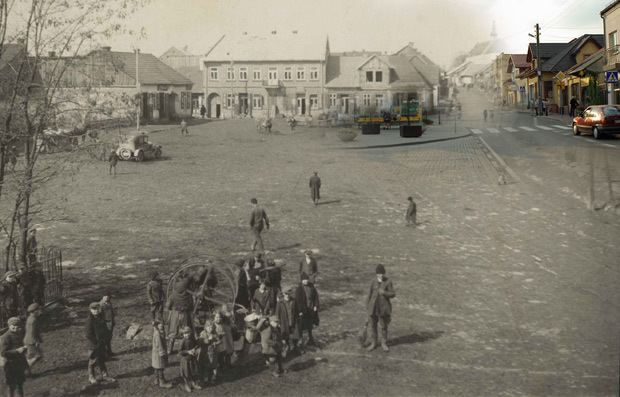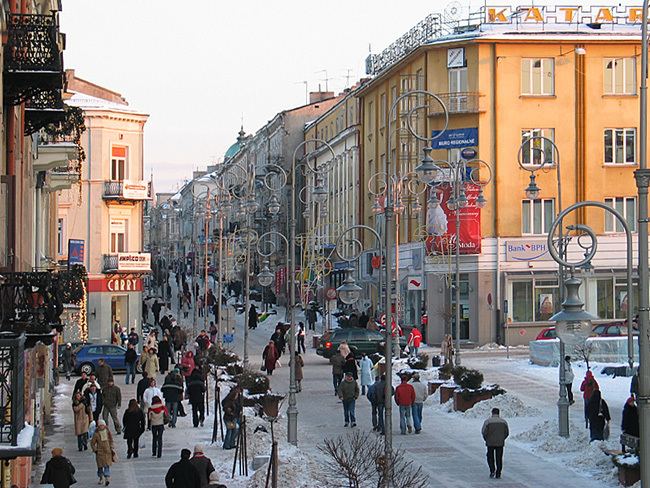Country Population 200,938 (2013) Area 109.65 km2 | Founded 11th century Mayor Wojciech Lubawski | |
Points of interest Swietokrzyskie Mountains, Sienkiewicz Street - Kielce, Palace of the Krakow Bishops in Kielce | ||
Kielce ([?k?elt?se is a city in central Poland with 199,475 inhabitants (June 2014). It is also the capital city of the Swietokrzyskie Voivodeship (Holy Cross Voivodeship) since 1999, previously in Kielce Voivodeship (1919–1939, 1945–1998). The city is located in the middle of the Swietokrzyskie Mountains (Holy Cross Mountains), at the banks of Silnica river, in northern part of the historical Polish province of Lesser Poland. Kielce was once an important centre of limestone mining.
Contents
- Map of Kielce
- Ten most interesting places in kielce
- Ks vive targi kielce vs thw kiel velux ehf final4 third place match
- History
- Jewish history
- Tourist attractions
- Culture
- Good food masters i klubowe mistrzostwa studenckie w jedzeniu na czas
- References
Map of Kielce
Ten most interesting places in kielce
Ks vive targi kielce vs thw kiel velux ehf final4 third place match
History

The area of Kielce has been inhabited since at least the 5th century BC. Until the 6th or 7th century the banks of the Silnica were inhabited by Celts. They were driven out by a Slavic tribe of Vistulans who started hunting in the nearby huge forests and had settled most of the area now known as Malopolska and present-day Swietokrzyskie Voivodeship. The lands of Wislanie were at first subdued by Bohemia, however they soon came under the control of the Piast dynasty and became a part of Poland. According to a local legend, Mieszko, son of Boleslaus II of Poland dreamt he was attacked by a band of brigands in a forest. In the dream he saw a vision of Saint Adalbert who drew a winding line which turned into a stream. When Mieszko woke up, he found the Silnica River whose waters helped him regain strength. He also discovered huge white tusks of an unknown animal. Mieszko announced he would build a town and a church to St. Adalbert at that site. According to this legend, the towns name Kielce commemorates the mysterious tusks (kiel in Polish).

Various other legends exist to explain the names origin. One states that the town was named after its founder who belonged to the noble family of Kielcz, while another claims that it stems from the Kelts who may have lived in the area in previous centuries. Other theories connect the towns name to occupational names relating to mud huts, iron tips for arrows and spears, or the production of tar (pkielce, a settlement of tar makers). The earliest extant document referring to the settlement by the name of Kielce dates to 1213.
The area of the Holy Cross Mountains was almost unpopulated until the 11th century when the first hunters established permanent settlements at the outskirts of the mountains. They needed a place to trade furs and meat for grain and other necessary products, and so the market of Kielce was formed. In the early 12th century the new settlement became a property of the Bishops of Krakow, who built a wooden church and a manor. In 1171 a stone church was erected by bishop Gedeon Gryf. During the times of Wincenty Kadlubek a parochial school in Kielce was opened in 1229. By 1295 the town was granted city rights. In the mid-13th century the town was destroyed by the Mongol invasion of Ogedei Khan, but it quickly recovered.
The area around Kielce was rich in minerals such as copper ore, lead ore, and iron, as well as limestone. In the 15th century Kielce became a significant centre of metallurgy. There were also several glass factories and armourer shops in the town. In 1527 bishop Piotr Tomicki founded a bell for the church and between 1637 and 1642 Manierist palace was erected near the market place by Bishop Jakub Zadzik. It is one of the very few examples of French Renaissance architecture in Poland and the only example of a magnates manor from the times of Vasa dynasty to survive World War II.
During The Deluge the town was pillaged and burnt by the Swedes. Only the palace and the church survived, but the town managed to recover under the rule of bishop Andrzej Zaluski. By 1761 Kielce had more than 4,000 inhabitants. In 1789 Kielce were nationalised and the burgers were granted the right to elect their own representatives in Sejm. Until the end of the century the citys economy entered a period of fast growth. A brewery was founded as well as several brick factories, a horse breeder, hospital.
Jewish history
Up until the Second World War, like many other cities in Europe, Kielce had a significant Jewish population: according to the Russian census of 1897, out of the total population of 23,200, Jews constituted 6,400 (around 27% percent). On the eve of the Second World War there were 24,000 Jewish inhabitants in Kielce, around one-third of the population at the time. Immediately after the German occupation in September 1939 action was taken against the Jews in the form of fines, confiscation of property, forced labour, deportation to concentration camps, and genocide. In April 1941, the Jewish ghetto was established, and the Jews were forced to move into it. During this time, many of them were forced to work at a nearby German ammunition plant. In August 1942, the extermination of the Jewish ghetto began and in 5 days only 2,000 were left. Those who survived the massacre were sent to another forced labour camp before going to the Treblinka extermination camp.
Tourist attractions
Culture

